I am travelling today to Tokyo and have little time to write here. But with…
Australian national accounts – growth on back of volatile exports
Today, the Australian Bureau of Statistics released the – March-quarter 2016 National Accounts data – which showed that real GDP grew strongly by 1.1 per cent in the three months to March 2016 (up from 0.6 per cent in the December-quarter 2015). It was largely driven by strong exports growth (and declining imports growth). In addition, private household consumption maintained a (declining) contribution as did public consumption. The negative growth in private investment means that potential output in Australia and future growth rates will be lower than otherwise. Not a positive sign. The other notable result was the increasing evidence that Australia continues to be in an income recession. Real net national disposable income fell by 1.3 per cent over the last year (to March) although the recent negative quarterly trend was arrested in the latest figures. The data continues to confirm that Australia faces a very uncertain outlook and the dependence on the volatile exports suggests a roller coaster ride ahead.
The main features of the National Accounts release for the March-quarter 2016 were (seasonally adjusted):
- Real GDP increased by 1.1 per cent after recording a 0.6 per cent increase in the September-quarter. The annual growth rate is 3.1 per cent, which is barely sufficient to keep unemployment from rising.
- The main positive contributors to expenditure were Exports (Mining related), which contributed 1.1 percentage points, and Household final consumption expenditure, which contributed 0.4 percentage points to GDP growth.
- The main negative factors were the decline in Private gross fixed capital formation of 2.2 per cent (New engineering construction fell by 6.4 per cent and new buildings by 6.9 per cent).
- Our Terms of Trade (seasonally adjusted) fell by 1.9 per cent in the quarter, and, over the 12 months to the end of March 2016, they have fallen by a substantial 11.5 per cent.
- Real net national disposable income, which is a broader measure of change in national economic well-being rose by 0.2 per cent for the quarter but fell by 1.3 per cent for the 12 months to the March-quarter 2016, which means that Australians are worse off (on average) than they were at that point 12 months ago. This is the income recession that economists are now speaking about.
- The Household saving ratio rose to 8.1 per cent (from 7.6 per cent) but remains well below the levels we saw just after the GFC. The problem now is that flat wages are straining households who are resorting to credit to sustain consumption expenditure.
Overall growth picture – growth on the back of mining exports
The following graph shows the quarterly percentage growth in real GDP over the last five years to the March-quarter 2016 (blue columns) and the ABS trend series (red line) superimposed.
The mining boom was thought to be in two stages. First, the investment boom as new productive infrastructure was being constructed (railways, ports, loaders, new sites etc). Second, the export boom that would result from the enlarged productive capacity. The second stage relied on continued growth in China to boost volumes and the prices remaining at elevated levels.
The problem is that China has now stepped down to a slower growth rate and our net exports now showing signs of volatility (see next section on contributions).
It is clear that commodity prices have peaked – our terms of trade are down 11.5 per cent over the last year, although the decline seems to have reached its low point for now.
Even with difficult world conditions, our export performance in the March-quarter 2016 was very robust.
Exports grew strongly in the March-quarter while imports fell.
The overall assessment is that the Australian economy continues to grow but below trend, although there is now a debate going on with suggests that trend growth is now lower (around 2.7 to 2.8 per cent) than previously thought (around 3.25 per cent).
At any rate, annual growth of 3.1 per cent in the March-quarter is still a decent result in the circumstances.
However, domestic wages growth is flat and real wages are falling. Household are driving consumption growth (albeit at declining rates) by maintaining reduced levels of saving out of disposable income (see later section), and household indebtedness is at record levels.
Analysis of Expenditure Components
The following graph shows the quarterly percentage growth for the major expenditure components in real terms for the March-quarter 2016 (blue bars) and the December-quarter 2015 (grey bars).
Domestic demand growth fell from 0.5 per cent in the December-quarter 2015, to 0.13 per cent in the March-quarter 2016 as a result of continued (albeit slowing) growth in household consumption (0.67 per cent growth down from 0.76 per cent), a slight boost in the growth in public consumption spending (0.87 per cent up from 0.57 per cent), and continued growth in public capital formation (0.69 per cent down from 5.76 per cent growth).
Private investment continued to fall (-2.16 per cent) after a decline of 1.37 per cent in the December-quarter 2015.
The standout was the growth in exports (4.37 per cent up from a flat 0.44 per cent in the December-quarter 2015). The weakening domestic demand also saw expenditure on imports fall by 0.81 per cent.
Contributions to growth
What components of expenditure added to and subtracted from real GDP growth in the March-quarter 2016?
The following bar graph shows the contributions to real GDP growth (in percentage points) for the main expenditure categories. It compares the March-quarter 2016 contributions (blue bars) with the December-quarter 2015 (gray bars).
The strongest contributor to real GDP growth in the March-quarter 2016 was Net Exports (1.2 percentage points) driven by a rise in exports and a fall in imports.
Private household consumption contributed 0.4 percentage points, followed by Public consumption (0.2 percentage points).
The overall contribution of the government sector to growth was 0.2 percentage points.
That is, the government sector contributed just under 20 per cent of the real GDP growth in the March-quarter 2016.
The overall contribution of private investment on growth continued to be negative (-0.4 percentage points), which confirms that the investment cycle associated with the mining boom is well and truly over and non-mining investment is not picking up the slack.
The next graph shows the contributions to real GDP growth of the major expenditure aggregates since the March-quarter 2015 (in percentage points). The total real GDP growth (in per cent) is also included as a reference.
The volatility of the exports contribution is notable.
Real GDP growth positive but real net national disposable income growth negative
The ABS tell us that:
A broader measure of change in national economic well-being is Real net national disposable income. This measure adjusts the volume measure of GDP for the Terms of trade effect, Real net incomes from overseas and Consumption of fixed capital.
While real GDP growth (that is, total output produced in volume terms) grew by 1.1 per cent quarter, real net national disposable income growth grew by only 0.2 per cent.
Real net national disposable income growth has been weak since 2011 and has been criss-crossing the zero line for the last three or so years.
Over the last year (to end of March 2016), real net national disposable income has declined by 1.1 per cent – which suggests that Australia is caught up in a “national income recession”.
In other words, Australians are poorer in income terms that they were at the beginning of 2015.
The following graph shows the evolution of the quarterly growth rates for the two series since the March-quarter 2006. You can see the divergence between real growth in output (and income that is generated by the economy) and the real net national disposable income (the real income Australians get) over the last few years.
So while the economy is pumping out mining exports at increasing volumes, Australian households are going backwards in real income terms.
This subdued state is the result of the declining export prices manifesting in the significant decline over the last 12 months in Australia’s terms of trade and the flat wages situation.
In other words, our capacity (in real terms) to purchase imports has declined per unit of export and Australian workers are not sharing in productivity growth.
It means that Australians overall are poorer even though we are still producing more than 12 months ago.
This discrepancy is one reason why an export-led growth strategy will not necessarily increase the standard of living of domestic residents, even if it exports grow.
Household saving ratio rises slightly to 8.1 per cent
The squeeze on wages in Australia is manifesting in two ways. Rising indebtedness and falling saving out of disposable income.
The following graph shows the household saving ratio (% of disposable income) from 2000 to the current period. The household saving ratio rose slightly in the March-quarter 2016 to 8.1 per cent after declining sharply in the December-quarter 2015.
Further, even though Household consumption expenditure remains positive and helping maintain overall growth in the face of negative private investment and faltering exports, it is decelerating as a result of subdued real wages.
The decline in the Household saving ratio from its 2011 levels is associated with a rise in household indebtedness – back to record levels.
After the GFC hit, the household sector sought to reduce the precariousness in its balance sheet exposed by the GFC.
Prior to the crisis, households maintained very robust spending (including housing) by accumulating record levels of debt. As the crisis hit, it was only because the central bank reduced interest rates quickly, that there were not mass bankruptcies.
In June 2012, the ratio was 11.6 per cent. Since the December-quarter 2013, it has been steadily falling as the squeze on wages has intensified.
While the recent trend is downwards, it is unlikely that households will return to the very low and negative saving ratios at the height of the credit binge given that the household sector is now carrying record levels of debt.
At some point, household consumption growth will fall unless growth is supported by public spending (given the poor outlook for private investment and net exports).
This also means that government surpluses which were strong>only were made possible by the household credit binge are untenable in this new (old) climate. The Government needs to learn about these macroeconomic connections. It will learn the hard way as net exports weaken if it tries to impose austerity.
Real GDP growth and hours worked
Over the last several years, there has been the sharp dislocation between what is happening in the labour market and what the National Accounts data has been telling us.
Growth in employment and hours worked has been very modest over the period while annual real GDP growth has been around 3 per cent.
At those GDP growth rates, employment growth should be much stronger than it has been.
Today’s data shows that GDP per hour worked rose sharply in the March-quarter 2016 (1.7 per cent) after falling in the December-quarter 2015 (-0.4 per cent).
This is the reason why growth in hours worked was close to zero (0.1 per cent) and well below the real GDP growth rate (1.1 per cent).
The following graph presents quarterly growth rates in trend GDP and hours worked using the National Accounts data for the last five years to the March-quarter 2016.
You can see the major dislocation between the two measures that appeared in the middle of 2011 persisted throughout 2013 and has reasserted itself on occasions when labour productivity growth has been weak in recent quarters.
The GDP growth was driven by capital-intensive exports which is one reason why labour productivity growth was strong and employment growth weak.
Just in case you think the labour force data is suspect, the hours worked computed from that data is very similar to that computed from the National Accounts.
To see the above graph from a different perspective, the next graph shows the annual growth in GDP per hour worked (so a measure of labour productivity) from the March-quarter 2007 quarter to the March-quarter 2016. The horizontal blue line is the average annual growth since December-quarter 2007.
The relatively strong growth in labour productivity in 2012 and the mostly above average growth in 2013 and 2014 helps explain why employment growth has been lagging given the real GDP growth. Growth in labour productivity means that for each output level less labour is required.
In the March-quarter 2016, annual labour productivity growth was 1.7 per cent (above the recent average of 1.5 per cent).
Conclusion
Today’s National Accounts data indicates that the Australian economy is now experiencing the second-phase of the Mining boom where exports grow strongly and pushes overall growth up towards its recent trend.
However, the export performance in recent years has been quite variable and with China slowing down it is unclear how long the March-quarter 2016 results will persist. I suspect next quarter’s results will be less favourable.
The main contributors to growth other than exports were Private household consumption (albeit declining) and public sector spending.
Growth in domestic demand was relatively weak as a result of the continued decline in private nvestment expenditure, which is undermining future prosperity.
The negative growth in private investment means that potential output in Australia and future growth rates will be lower than otherwise. Again, not a positive sign.
The other notable result was the increasing evidence that Australia continues to be in an income recession with real net national disposable income declining over the last 12 months to March 2016.
Taken together, the future is very uncertain although an annual growth rate of 3.1 per cent is reasonable given the circumstances.
Paperback version of my Eurozone book now available
My current book – Eurozone Dystopia: Groupthink and Denial on a Grand Scale (published May 2015) – carries an on-line price of £99.00.
It is now available in much cheaper paperback form for £32.00.
Also the eBook is available 36.27 US dollars from Google Play or 61.45 Australian dollars from eBooks.com.
That is enough for today!
(c) Copyright 2016 William Mitchell. All Rights Reserved.
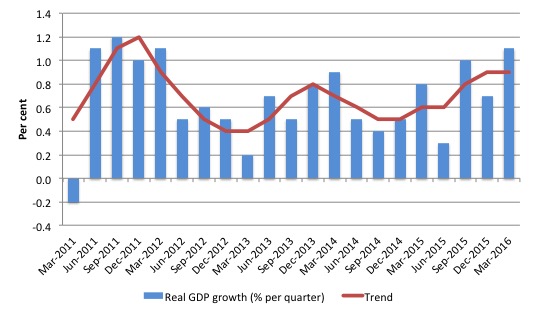
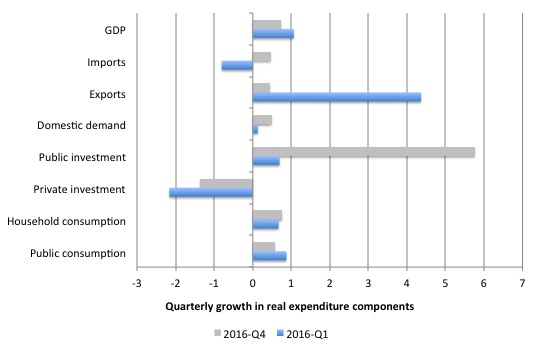
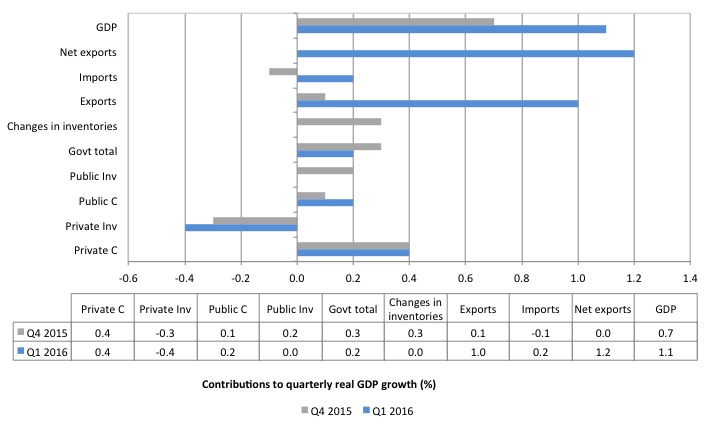
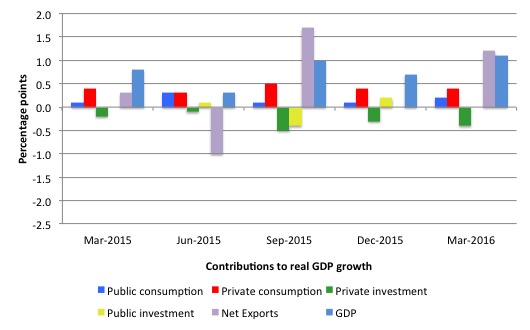
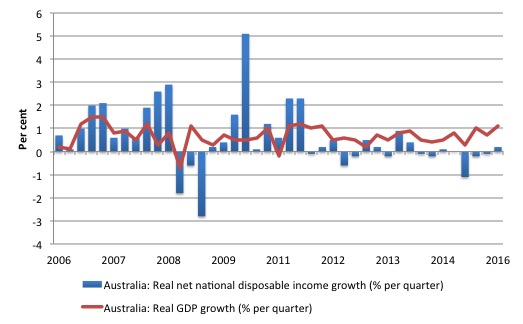
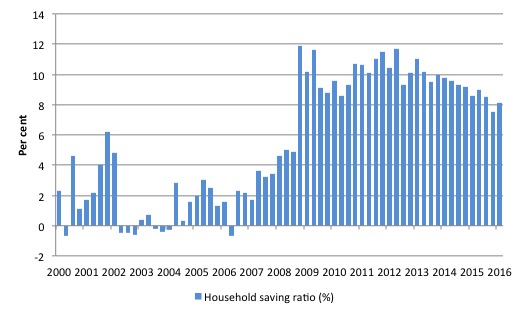
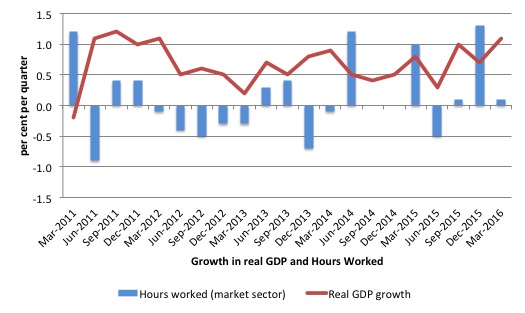
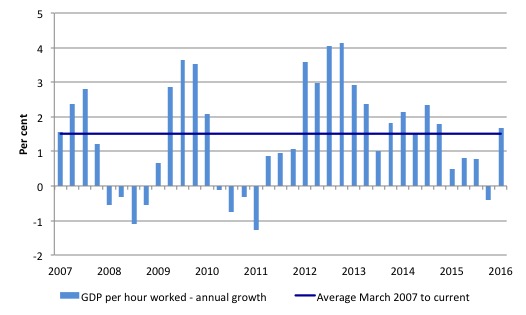
Wonder if you could focus today on the other part of the GDP data – the continued weakness in price pressures as highlighted in the various deflators – the IP deflator up ONCE in last 8 qtrs … PCE negative for the first time in decades …?
Again well written for a novice like me! I just love seeing politicians put their spin on the figures it’s like a dog waiting for crumbs to fall off the table!
Given the stong contribution made by mining towards Australia’s exports, if one also subtracts the liquidation of mineral desposits – which are capital assets – from GDP to obtain an even truer measure of net disposable income, the picture is grimmer still. Why subtract the Consumption of Fixed Capital (manufactured capital) but not the consumption of natural capital?
What should also be subtracted are “defensive and rehabilitative expenditures” since income is correctly defined as the maximum amount that can be consumed over a given period without compromising the ability to consume at least the same amount in the following period and beyond. It is impossible for a nation to consume all of its real output and satisfy this principle.
The same subtractions should also be made on the Current Account.